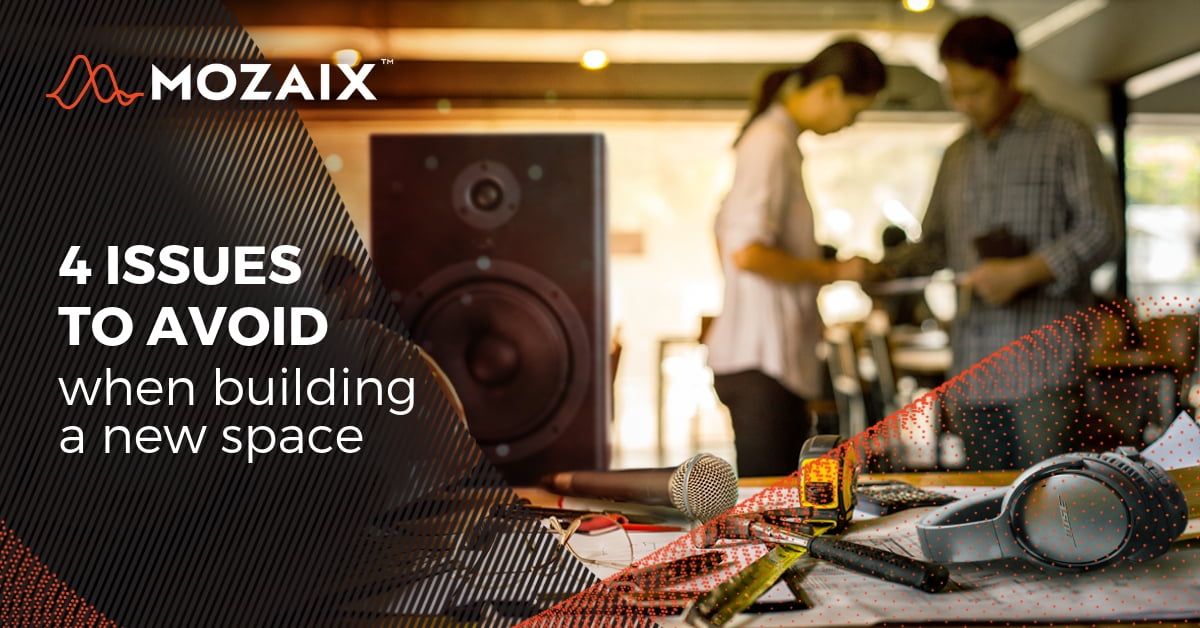
4 issues to avoid when building a new space
When it comes to building a new space, people often come to us with an exciting vision, yet a variety of pitfalls that could have been avoided.
Whilst audio-visual planning tends to occur at the right time during the building design process, its implementation is often left until after the space is complete.
The truth is, audio-visual planning requires far more than just choosing the right equipment. There are many variables that can influence the end result of your equipment, and these need to be considered during the design process.
Here are four issues to avoid when building a new space:
Don’t leave it to the last minute

People may think of installing an AV system as something that goes in after a space has been built.
They might think of mounting a TV or display on a wall, or installing speakers on a ceiling or a wall. It is common for people to overlook the infrastructure in the background, such as cabling etc.
A current trend in building is the use of steel studs in walls. While this is an efficient way to support a plaster wall, it can create issues if you’re going to hang anything on that wall. If you plan to wall mount a TV you’re likely to need to use timber studs in that section of the wall. Steel studs are thin and flex under load so the weight of a TV would be likely to flex steel studs behind your wall which is likely to compromise your plaster work.
Whether you’re planning a large or small AV system, it’s worth discussing your AV plans with a professional before your building plans are complete. Running cables through walls and ceilings is much easier before your plaster work is painted, and your cabinetry is installed. Getting your AV installer in early can be more efficient, saving you a lot of heartache and money in the long run.
Be mindful of noisy surfaces

The materials used in your build can have a significant impact on the acoustic properties of a room.
Before you sign off on your stunning new architecture, there are a few things you should consider. Your primary consideration should be the function of a space, and there are a few things that can make a real difference to how your space is experienced.
Building materials can make a real difference to the acoustic properties of a space. Glass rooms, tiled walls and polished concrete or vinyl floors can look stunning, but keep in mind when considering these options that hard surfaces reflect sound. This can cause echoing and exaggerate the noise level in the room. In bad cases it can make your talking volume sound like a shouting volume or create echoes that can cause feedback in microphones.
When planning rooms with hard surfaces it could be beneficial to include some soft furnishing to absorb some of the sound, or use angles to dissipate sound waves. To appreciate this, consider the difference between singing in the shower with a glass door and tile walls, compared to talking (or singing if you’re so inclined) in the bedroom with heavy curtains and soft furnishings. Materials such as plaster walls, Carpet floors, timber furnishings, curtains, canvas paintings and plants are just some ways you can manage a noisy room.
There are many creative ways to improve the acoustic properties of a room with hard surfaces and it may be worth discussing this with your architect , builder or AV integrator.
Avoid overloading your network

Modern audio visual systems are making more and more use of data networking, both to control parts of the system, and to connect audio and video devices. While this opens the doors to a great variety of media applications, it can also raise potential issues.
Plugging your AV gear into your pre-existing IT network can make your system more flexible, and more cost effective to set up, however may not be ideal if your AV system is going to be comprehensive, or the IT skills available to you are limited.
When you’re looking to install a sizable AV system with a healthy appetite for data, you may want to consider installing a separate network for your AV system. Too much traffic or too many types of traffic over a network can create issues with band width, or slow down a system as devices check every data packet passing by to see if it belongs to that device. Keep in mind, many venues now have all their computers, telephones, staff devices, control systems and audio visual equipment sharing the IT network.
Having a dedicated AV network can free up your IT network and ensure your AV and IT systems run more efficiently as only the relevant data traffic will be on the network. If your venue is a heavy user of Video, it’s worth remember video is a thirsty media source. If you plan to stream video to multiple displays you may wish to consider installing a second internet connection.
In many situations, it can work well for your AV system to share your IT network, however it is worth considering the size and complexity of your IT system, and the IT skills available to you. Armed with that you can set about getting some good advice to determine the best approach for your system.
The shape of things

While it’s rare that the shape of your space will have a great impact on the acoustic properties of a room, we have seen occasions where an aesthetic design has resulted in acoustic problems.
Sound can carry across open spaces, especially if that open space is lined with hard surfaces that reflect sound (remember our singing in the shower example). Such environments can make conversations awkward when rooms are empty or noisy when populated. This can normally be aided by a good Background Music System.
If you’re considering putting some curves or domes in your architectural plans, it may be worth considering the shapes of these, especially if they’re to be made of hard/reflective materials. Some examples may be a curved wall behind reception or a dome sculpture or ceiling.
If you’ve ever walked through an audio Echo Dome at a shopping center you’ll appreciate the way the dome seems to amplify your voice. A concave shape may seem to amplify sound by channeling sound waves back in the direction they came from, a convex shape will disburse the sound around the room.
Perhaps your issue isn’t so much the shape of things, but the size of things. If you’re already experiencing problems but don’t have the floor space for random shapes, soft furnishing or plants, there are now a growing variety of unobtrusive noise reducing furnishings available. These can take the shape of paneling similar to a feature wall, or solutions that can be hung from a ceiling with a variety of aesthetics. These are typically soft materials configured in a random way that is pleasing to the eye, they act to absorb and disrupt sound waves and can be a very effective solution.
If you are experiencing any problems, have concerns or are planning a new space, the team at Mozaix will be more than happy to offer advice on assist with the management or planning of your space.